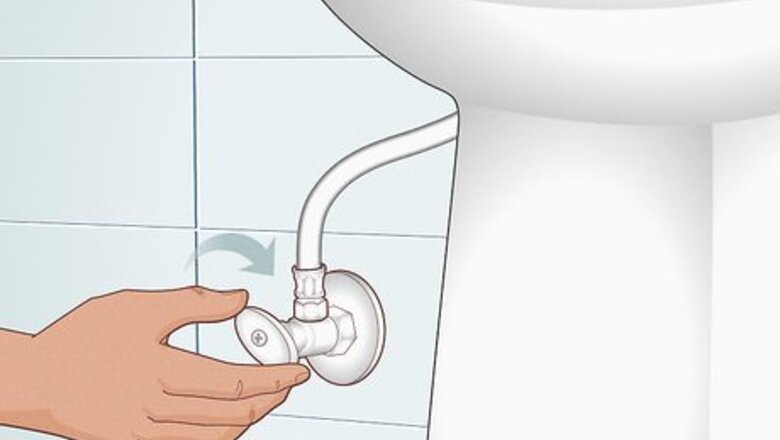
views
Removing the Existing Valve
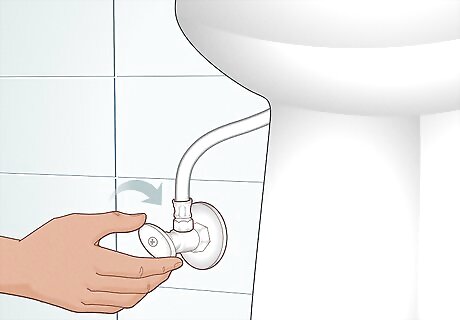
Turn off the water supply. Before doing any repairs to your toilet you should turn off the water outside of the toilet. You should have a water valve directly below the toilet tank. It should be located between where the water pipe comes out of the wall and where it attaches to the bottom of the toilet tank. In most cases, you will turn the water shutoff valve clockwise to turn it off. Be sure to continue turning it until it stops moving. EXPERT TIP James Schuelke James Schuelke Professional Plumber James Schuelke, along with his twin brother David, is the co-owner of the Twin Home Experts, a licensed plumbing, leak detection, and mold inspection company based in Los Angeles, California. James has over 32 years of home service and business plumbing experience and has expanded the Twin Home Experts to Phoenix, Arizona and the Pacific Northwest. James Schuelke James Schuelke Professional Plumber It's a good idea to turn off your main water valve, as well. Find the main water shut-off valve on the outside of your home and turn it off. Then, go around your property and turn on various fixtures to confirm that they're off, but it will also drain off residual water that's inside the system. Doing this will help you avoid water damage due to a flood.
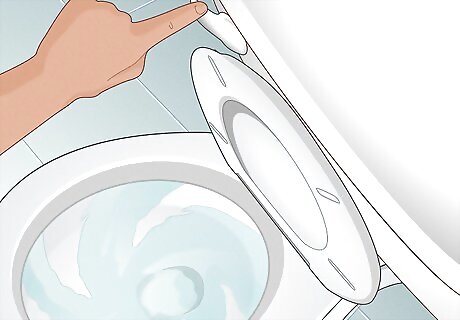
Drain the toilet tank. Once the water is turned off, drain the tank before you can disconnect the toilet fill valve. To begin draining the tank, flush the toilet and hold the flush lever down to remove as much water as possible. Once most of the water is gone, you will need to use a turkey baster or a wet-dry vacuum to get rid of the small amount of water sitting at the bottom of the tank. If you don't have a turkey baster or wet-dry vacuum, use an old towel or sponge to soak up the remaining water and any sediment left in the tank.
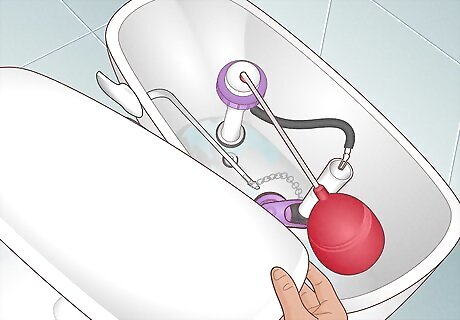
Locate the toilet fill valve. Remove the tank lid carefully and set it on a towel out of the way so it doesn’t get broken. The toilet fill valve is located inside the toilet tank, usually off to one side. In newer toilets, it is the entire plastic column that includes the float and the on-off lever for filling. In older toilets, the float is a separate piece but it will be connected to the top of the fill valve. The fill valve also has a tube attached to it that connects to the overflow pipe.
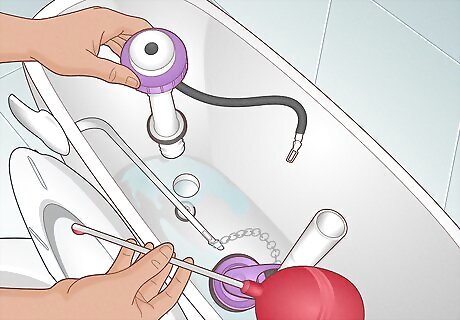
Detach the toilet fill valve. Loosen the nut that secures the fill valve to the water supply line by turning it counterclockwise with pliers or a wrench. Then, carefully pull the supply line out of the valve underneath the tank. As you unscrew the nut, a bit of water may drip out of the tank. Keep a towel on hand or on the floor below the opening to catch any water that comes out.
Installing a New Valve
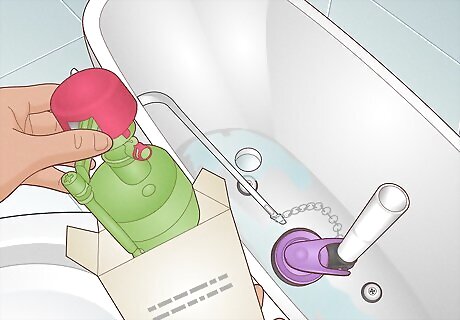
Purchase a new toilet fill valve. Go to your local hardware store and purchase a new toilet fill valve. Most new toilet fill valves are universal, meaning they will fit in almost any toilet. However, if you are worried about fit, take your old toilet valve with you to the store and use it to assess whether a potential replacement will work. Even if your old toilet fill valve had a separate float, a newer valve with the float integrated onto the shaft will work.
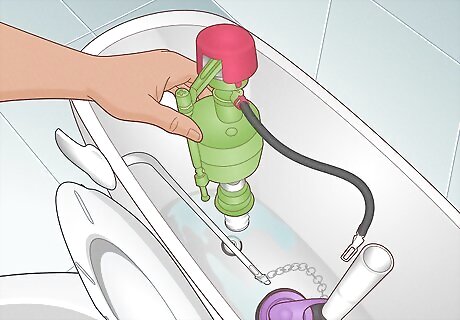
Put the new toilet fill valve in place. Remove the new toilet fill valve from its packaging. Be sure to read the directions it comes with. The fill valve should come fully assembled, so you should be able to put it straight into the toilet. Remember to also clip the new refill tube to the overflow tube.
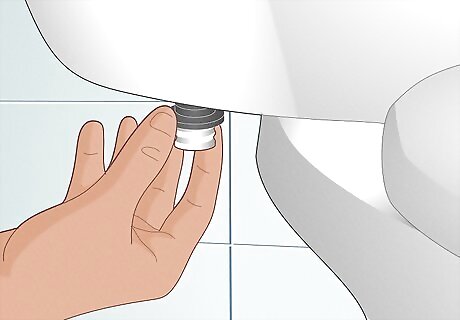
Make sure all the washers are in place. It is important to pay attention to how any included washers and nuts should be attached to the valve. There should be washers on the inside and the outside of the tank where the fill valve goes through it. Washers on the inside and outside of the tank ensure that there is a water-tight seal around this connection point.
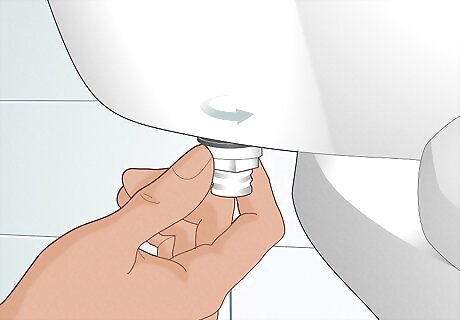
Tighten the fill valve nut carefully. When you have the toilet fill valve in place, the final part of its installation is to tighten a lock nut onto the threaded part of the valve. This is located on the underside of the tank. When doing this, it is important not to tighten the nut too hard. The nut should be tightened by hand to ensure that you don't tighten it too much. Tightening the nut on the bottom of the fill valve with a wrench or pliers could crack the toilet tank or the valve.
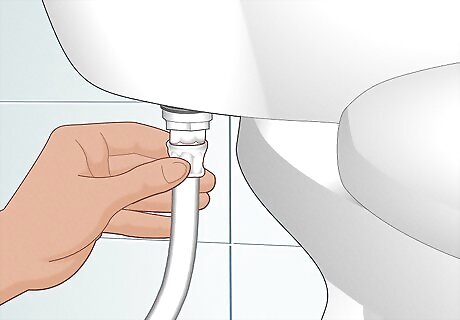
Reattach the water supply line and turn on the water. Once the replacement fill valve is in place, it's time to get the water flowing again. Attach the supply line to the bottom of the new fill valve. Make sure that there is a washer inside the end of the supply line and tighten it with a wrench until it’s tight. Then turn on the water by turning the shutoff valve counter clockwise until it stops rotating. Be careful not to overtighten the washer, or the nut could crack and the connection will leak. If you see any leaks, immediately turn the water off at the shutoff valve. When you turn the water on, the tank should start filling right away. EXPERT TIP James Schuelke James Schuelke Professional Plumber James Schuelke, along with his twin brother David, is the co-owner of the Twin Home Experts, a licensed plumbing, leak detection, and mold inspection company based in Los Angeles, California. James has over 32 years of home service and business plumbing experience and has expanded the Twin Home Experts to Phoenix, Arizona and the Pacific Northwest. James Schuelke James Schuelke Professional Plumber Be very cautious as you turn the water back on. Once the valve is on, turn the main water supply on very slowly, and have a second person go into the bathroom and make sure there are no leaks as you regenerate the water system.
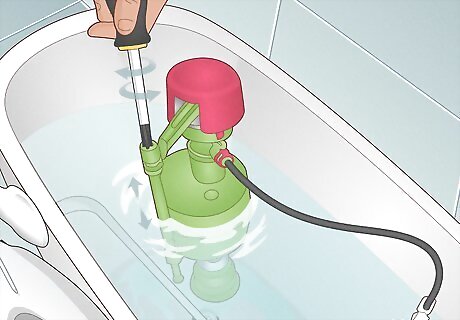
Adjust the float. Once the water is turned back on and your toilet tank has filled, then you can adjust the float on your new toilet fill valve. The float's location can be adjusted with a clip on its side, a set screw at the top of the float shaft, or by adjusting a screw at the top of fill valve where the float attaches. Look at the directions of your new toilet fill valve for exact directions for float adjustment. When positioned correctly, the top of the float should be set at about 1 inch (2.5 cm) below the top of the overflow pipe. The goal is that the float comes up and shuts off the water before the water gets high enough to flow over the top of the overflow pipe.














Comments
0 comment